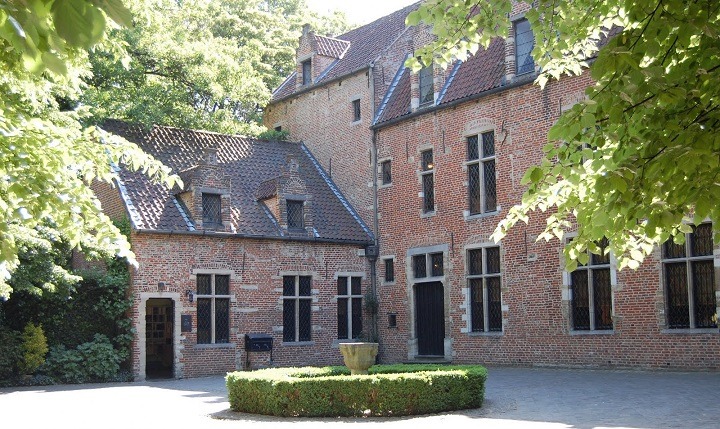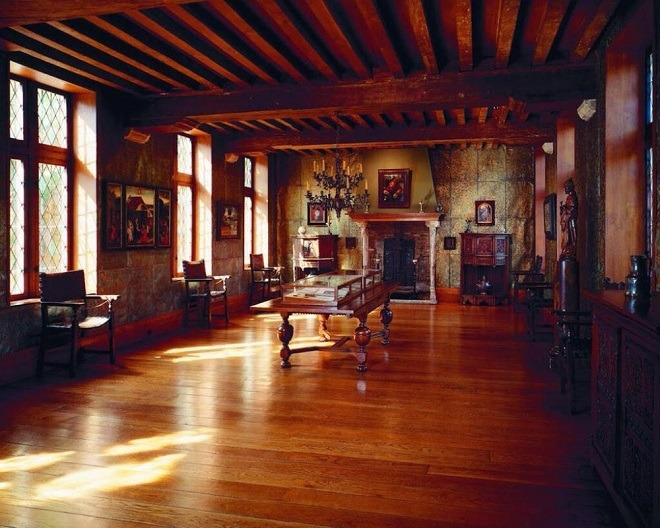One of the EU’s most successful projects is linked to a 500-year-old brick house in Anderlecht. We take a look around the Erasmus House Museum. It’s hard to escape Erasmus in Brussels. The city has a hospital, metro station and university, all named after Erasmus. It also has hundreds of students taking advantage of the hugely popular Erasmus exchange programme launched by the EU 30 years ago. But not many people know about an obscure little museum in a quiet street in Anderlecht named after Erasmus.
You find the Erasmus House by taking the metro to Saint Guidon and then walking in the direction of the St Guidon church spire. Turn down a side street and you will see a brick house with Flemish step gables dating from the early 16th century. The plaque next to the entrance tells you that this is Erasmi Domum, the Erasmus House. It adds, under a portrait of Erasmus, Petrofina Refecit, Restored by Petrofina.
The name Erasmi Domum is a bit misleading because he only stayed here for five months in the summer of 1521. But then Erasmus, who was born in the Netherlands, was always on the move. His friend Pieter Wychman, a canon in Brussels Cathedral, invited him to spend some time in this house in the village of Anderlecht, close to the Collegiate Church of Saint Gudule. Erasmus arrived in May and stayed until October. He spent much of the time working on a translation of the New Testament from Greek into Latin.
The house is a beautiful example of Flemish brick gothic style. It was built between 1480 and 1515, making it one of the oldest buildings in Brussels. It is also one of the cheapest museums in the city – just €1,25 will get you inside.

Erasmus House Museum
The building was little more than a ruin when the local council bought it in 1931. The aim was to turn it into a museum. But there was nothing left from Erasmus’ time, so the museum had to furnish the interior from scratch. The rooms were slowly filled with furniture and paintings from the early 16th century.
The end result might not be authentic, but it is still fascinating to wander through the Flemish renaissance rooms and climb the creaky wooden staircase. The interiors are furnished with oak chests, gilt leather walls and 16th century paintings. The leaded glass windows fill the rooms with a dusty golden light like a Dutch painting.

The curators have built up an interesting collection of paintings that reflect the spirit of the age. The most striking work is an Adoration of the Magi painted in about 1485 by Hieronymus Bosch, moved here from a local church. And Erasmus himself appears in the background of a painting of The Judgement of Solomon by Frans Francken the Younger.
The curators didn’t stop at paintings. Over the years, they have built up a strange and eclectic collection of Erasmus memorabilia, ranging from theatre posters to banknotes with portraits of Erasmus. One of the oddest items in the collection is a British railway poster using Erasmus’ portrait to advertise excursions to Cambridge, where he spent several miserable months teaching theology and Greek.
The most attractive room in the house is called Erasmus’ Study, although there is no evidence that he ever used the room. It is in fact a replica of the interior in a famous woodcut portrait of Erasmus by Dürer. The German artist showed Erasmus sitting at his desk in the dead of winter wearing three coats and a thick hat pulled down over his ears.
Dürer began working on the portrait in Brussels in 1520, but got no further than a charcoal sketch. He told Erasmus he had lost the sketch, but he finally produced a woodcut version in 1525. It shows Erasmus holding an ink bottle in his left hand to prevent it from freezing. But Dürer wasn’t happy with the final result. “His works provide a better impression,” he added at the bottom.
And Erasmus was equally critical. In a letter to a friend, he grumbled: “Resemblance: none.” And then he added “It is hardly surprising that the portrait is not a better likeness, since I am not the same person that I was five years ago.”

Portrait of Erasmus
You might say the same about the Erasmus House, which is not the same house as it was 500 years ago. But the curators have worked hard to immerse visitors in the atmosphere of the renaissance. They have even created a website that reflects the spirit of Erasmus. When you click on the home page, you are offered a choice of six languages, including information in Latin.
It’s hard not to smile when you click on Vectura (Accessibility) and find instructions on how to get there by Autocineto (road) – Ring O, exitus 14 ou 16. Whereas if you choose to come by Tramineferrivario (metro), the directions are: Statio St Guidon directio Erasmus.
The museum has also put a lot of effort into planting the garden at the back of the house. The work was begun in 1988 by the Belgian landscape gardener René Pechère, who modelled it on formal mediaeval gardens seen in the background of mediaeval Flemish paintings and planted it with some 450 different medicinal herbs used in Erasmus’ day to cure illnesses.
A second garden was added in 2000 known as the Philosophical Garden. It was inspired by a text Erasmus wrote in Anderlecht titled the Religious Feast, where he set out to reconcile the deep conflict between Catholic Church and Martin Luther. It is a strange, mysterious spot with a curious gazebo made from hundreds of spectacle lenses.
In visiting this house and garden, you are gently introduced to the life of one of Europe’s great thinkers. Erasmus didn’t change the world, but he perhaps changed the way we think. In an age of religious extremism, he was humorous, playful and firmly anti-establishment.
Ubi bene ibi patria – Where I feel happy, that is my country, he once wrote. It could almost serve as a motto for the Erasmus student programme.
Erasmus House Museum
Rue du Chapitre 31, Anderlecht
www.erasmushouse.museum

